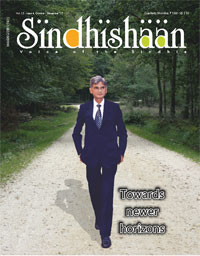A UNIQUE CASTE SYSTEM OF SINDHIS
By Sahib Bijani

As post partition Sindhis,we had often heard of Sindhi names/labels like Amils, Bhaibands, Sindhiwarkis, Hyderabadis and so on, but could not make sense of these so called ‘castes’ of the community. Sindhishaan requested veteran researcher Shri Sahib Bijani to simplify and explain the various ‘types’ to the Sindh community. Here is a summary of the extensive research conducted by Shri Bijani.
Sindhis don’t follow any caste system, but there are certain loosely defined ‘castes’ or ‘zaats’ that are distinct from each other as they have come to be associated with distinct cultural and behavioral characteristics. These qualities or traits arose either from their professional differences or from the cities and places of living. For example Hyderabadis are known because they lived in Hyderabad which was comparatively an advanced and prosperous city. Similarly Shikarpuris are people from Shikarpur. This way there are many classifications in the Sindhi community. We have tried to enumerate some of the better known types in this article.
AMILS – The word Amil comes from amal which means to practice. These are Hindu Kshatriyas who worked as accountants in the governments of Mirs and Kalhodas in Sindh. Nowadays their descendants are also known as Amils even though they may not be in service. Amils residing in Hyderabad would be known as Hyderabadi Amils. Some of the Amils also resided in Khairpur, Larkana and Sevanh. Hyderabadis are supposed to be of a higher Zaat, well educated and fair skinned because the city of Hyderabad in those days was an education and cultural hub.
BHAIBANDS – In Sindh, the business class of Sindhis was known as Bhaibands. These people were into trading and business activities in the kingdom of the Mirs. It would be possible to find one Amil brother and one Bhaiband brother in the same household. In those days Amils would marry only Amils and Bhaibands would marry only Bhaibands. Nowadays even though they may be in service, yet they are known as Bhaibands if their ancestors belonged to this caste.
SINDHWARKIS – Sindhwarkis are those Bhaibands of Sindh who traded in the materials made in Sindh and then exported it. In 1843, the British conquered Sindh and at that time, the Hyderabadi Bhaibands supplied the materials for daily needs to the British soldiers. Because of their contact with the British army they supplied all types of material to them, even from the villages of Sindh. Then these Bhaibands went to Bombay, from there to Columbia and Rangoon. In 1869 the Suez Canal was opened and many Sindhwarkis went to Europe and Singapore and then spread all over the world, and began trading from many other ports and cities. This is the now known category of Sindhi NRIs
CHHAPRUS – The word Chhapru comes from the word Chhappar meaning mountain. These people usually lived in the mountain regions in Sindh and later came down to stay in Karachi. Chhaprus have followed their own distinct rituals and customs. Some of the Chhaprus are also known as Saprus.
BHATIAS – Bhatias are descendants of Shri Krishna. There are thousands of Sindhi Bhatias all over the world today. They usually marry among themselves and are strict vegetarians. Many don’t even eat onions and garlic. Some of their sub-castes are Gajria, Kajria, Parmal etc.
MASANDS – Masands were appointed to spread Sikhism by the fourth Guru, Guru Ramdas. They would spread the message of Gurbani in small towns and villages and collect funds. Then on Diwali day they would go and meet their Guru and hand over the collection. They would then be honored by their Guru. Even today there are around 300 Masands in India; some of them are brilliant educationists and social workers.
THAKURS – These are the descendants of Lord Jhulelal. They are the official Brahmins of the Sindhi community. They head many Sindhi Tikanas and Durbars.
BHAGNARIS – There were two small villages in Baluchistan known as Bhag and Nari which explains the name of this Bhagnari community. They were the community of dry fruits and spice merchants of those days. Some Bhagnaris were also wine merchants. They strictly married in their own community. Some of the famous Bhagnaris are Popleys, Nanomal Issardas and so on.
LOHANAS – Lohanas are the desendants of Luv, the son of Bhagwan Ramchandra. They are the Kshatriyas who lived in an iron fort built by them in Punjab known as Loh-Ghar, which later came to be known as Lahore. They came to Sindh from Lahore from where many Lohanas migrated to Kutch. They are usually engaged in trading and other business.
There are many more such Jaatis in Sindhis and it is not possible to describe each and everyone in this small article. Efforts must be made to research, classify and tabulate these various castes and sub-castes because it has importance for the future generation.


